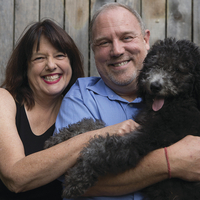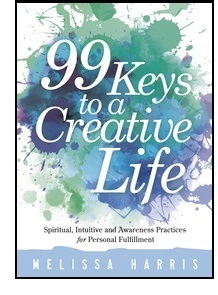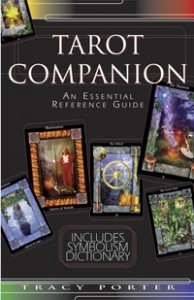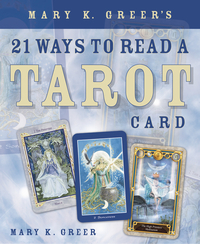Llewellyn Publications's Blog, page 52
July 6, 2016
The Heart Chakra and Tarot
Over the decades, we tarot lovers have created associations between lots of different systems and the cards. One of the reasons we love tarot is that it is flexible. In Tarot Companion, Tracy Porter has collected many of the most commonly used associations. While it is not hard to search for and find information on associations through various books and websites, it is really handy to have so many of them gathered together in one handy reference book.
Chakras are one of the not so common associations but whenever I meet a reader who uses them, I am always amazed by how much they can add to a reading. Here is an excerpt from her section on Chakras, in particular, the Heart Chakra:
The heart chakra is located in eh center of the chest. This chakra is associated with the color green and all four-legged mammals. The heart chakra is the seat of the astral body, which is the bridge between the material and spiritual bodies. This chakra deals with empathy or our ability to imaginatively project a subject thought into an objet so that the objects appears to be infused with the thought. The heart chakra energizes our physical bodies with the life force and helps ground the energy to our bodies. This chakra governs issues relating to unconditional love, feelings, forgiveness, compassion, understanding, openness, balance, rust, and oneness with life. When we negatively relate to heart chakra issues, we may repress love and become unbalance, distrustful, and emotionally unstable.
Physically, the heart chakra governs the circulation of the blood, heart, arms, hands, and lungs. When we have long-standing emotional problems relating to the heart chakra, we may develop heart problems, lung disease, or circulation problems, in order to force us to come to terms with these issues. People who tend to activate our heart chakras are those who teach us to love unconditionally, and these persons may put us into positions where we are forced to love them regardless of their wrongdoings. Because the heart chakra helps us remain balanced throughout life’s ups and downs, the harmonious qualities of 11, Justice and 14, Temperance represent this chakra. Because we are often asked to love unconditionally, those who seem to act at cross-purposes to our lives, 12, The Hanged Man asks us to make such sacrifices—as all that we give will eventually come back to us stronger than ever before.
July 5, 2016
Writing As Magick
Readers, please enjoy this guest blog post by Lasara Firefox Allen, author of the new Jailbreaking the Goddess.
 This pen, this keyboard, these are my magickal tools. They are more powerful for me then a blade, a chalice, a candle, a besom, a bell. These are my tools that easily cut a doorway between worlds. They create new trajectories, finding a path where there was none before.
This pen, this keyboard, these are my magickal tools. They are more powerful for me then a blade, a chalice, a candle, a besom, a bell. These are my tools that easily cut a doorway between worlds. They create new trajectories, finding a path where there was none before.
These tools are meta-magick: these tools create new tools. Tools in the form of words, prayers, stories of coming days toward which we may work. Weaving visions of more liberated, more just worlds, we seed potential. A spell here, a new word there, a new world over there. These are the magicks that transform effortlessly. Language is a virus. We infect, spreading liberation and empowerment.
I sit before my screen and dive in. I let my fingers work their prayers and incantations. Soon I am humming with the power of the word. I exist outside the confines of this moment. I am outside of time and space. I am in the cauldron. I am allowing creation to be wrought through me. I keep typing.
I am infused with spirit. Tears and laughter break free. I keep typing. I am a mad woman. I am in the throes of ecstasy, terror. I am at the molten core of transformation. I am a Witch, weaving new worlds.
May this work of creation serve the greater impulse toward liberation. May this song delivered through me allow for my own transformation, and for the transformation of others. May our stories be told. May the voices of Witches, and of women everywhere, rise up and be heard. May our primal, gut-heart-brain beings call for justice, and for understanding.
May this act benefit all beings.
Our thanks to Lasara for her guest post! For more from Lasara Firefox Allen, read her article, “How to Survive Waking Up.”
June 22, 2016
Letting Go of Fear
Christine Jette’s wonderful book, Tarot for the Healing Heart, teaches how to use tarot for issues of health and healing on all levels. For so many readers, this is the core of our work. Solving problems may be the first step, but then we usually dig deeper to find roots or causes that underpin the symptoms the initial reading presents. Jette includes a meditation on the Death card to support releasing of fear. The meditation is excerpted below:
The Death card, No. 13, traditionally means transformation, rebirth, letting go, and permanent change. It rarely signifies physical death, but for the purposes of this meditation, that is exactly what it means—coming to terms with your own mortality.
When you are able to accept your own death as inevitable, you gain a broader perspective of your life direction and the choices you are now making. Priorities become clearer and change is easier to make. The Death card meditation will assist you in understanding that the secret to being eternal is the capacity to give and receive love.
Pull from your tarot deck No. 13, the Death card. Sit comfortably and prop the card up in front of you. Allow the edges of the card to soften in your gaze. Concentrate on slow deep breathing.
As you gaze at Death, think about your own death. To get you started, answer the following questions: What odes dying mean to you? Are you afraid to die?
Pretend you are writing your own obituary. Let your whole life pass before you. How do you want to be remembered? What are your accomplishments? What gives your life meaning and purpose? What is the one thing you wish you could do that you have not yet done?
What has been the most significant death in your own life? If you have not experienced the death of a close friend or loved one, anticipate how would feel if a significant person in your life dies tomorrow. What do you fear most about this death? Record all your insights into your healing journal.
We can’t force ourselves to let go of fear of death, but by understanding how fear operates in our lives, we have a greater chance of releasing it. When we operate from a fear-based philosophy, it is difficult to give and receive love. In fear, love becomes possession and fear of loss controls our actions.
Somewhere along the way, we become fearful of death. When we operate out of fear, we set up the wrong life. When fear is released, we are then in a position to give and receive love without hidden agendas. By letting go of fear we choose a healing cycle—to become who we truly are instead of who we think we ought to be—and that’s the true meaning of dying in order to be reborn.
June 20, 2016
How Much Should You Meditate?
Readers, please enjoy this guest blog post by Doron Hanoch, author of the new Yoga Lifestyle.
 How much should you meditate? All the time! Meditation is not necessarily sitting down to quiet the mind, as for most of us, sitting down means either watching the mind with awareness or drowning within the stories of the head. For some meditation does allow a dropping into the present moment, and a sense of ease and peace. For some it even goes deeper beyond our conscious awareness, but this is rare, and hard to repeat even for those that have experienced it.
How much should you meditate? All the time! Meditation is not necessarily sitting down to quiet the mind, as for most of us, sitting down means either watching the mind with awareness or drowning within the stories of the head. For some meditation does allow a dropping into the present moment, and a sense of ease and peace. For some it even goes deeper beyond our conscious awareness, but this is rare, and hard to repeat even for those that have experienced it.
To make life a lot more blissful, we simply need to practice awareness, or mindfulness, repeatedly. A simple exercise is to stop every hour for two minutes and focus on your breath as it passes through the nose, and at the same time focus on your breath as it fills up the belly. This may appear to be multi-tasking—and you may know by now that I do not recommend to multi-task—but in actuality this is one task of being aware of the entire process. Since it takes more of the mind to be able to stay focused both on the nose and the belly at once, the mind has to soften and drop away from thoughts, as this is already a big task. This really allows the mind to rest for two minutes so that as you get back to whatever task you have at hand, you will see how much more focused and calm you are.
Stop for 2 minutes (have a timer always ready).
Take a breath in and notice the air as it passes the nostrils AND at the same time try to notice the belly fill up.
Exhale slowly and notice the belly empty AND at the same time feel the warm air through the nose.
You may want to stay for a few extra breaths just enjoying the peace.
Enjoy! Really, you are getting a break.
In between these two-minute breathing practices, keep practicing staying present. The more present you are with tasks that do not require creative thinking, the less useless thinking you will add to your mind. Simply follow with your eyes the process of any action, from beginning to end. If you are placing a glass down on a table, watch your hand placing it down, as well as your hand leaving the glass and moving on to your next task. You can begin by doing this practice while eating, and then expand it further to other things you do that do not require creative thinking.
If you do have a meditation practice, it works well to sit at least twenty minutes, and even thirty or forty minutes. It takes the mind a bit of time to settle, and to allow repeated thinking to soften. Sitting for these longer periods is great in the morning. Start with ten minutes, and build it up from there. Maybe once a week do a longer meditation period of thirty to forty minutes.
More techniques and happy yoga lifestyle practices can be found in my book The Yoga Lifestyle, published by Llewellyn.
Our thanks to Doron for his guest post! For more from Doron Hanoch, read his article, “5 Uncommon Tips to Release Stress Using the Flexitarian Method.”
June 14, 2016
Llewellyn’s 2016 Tarot Catalog Is Here!
We are proud to bring our readers our sixth annual tarot catalog! Discover the newest in tarot offerings from Llewellyn, Lo Scarabeo, and Blue Angel, plus get free shipping on US orders over $30 and 20% savings when you order online with the promo code found on the cover! Hurry, savings good through 8/1/16!
Open publication
June 13, 2016
In the Beginning Was the Dog
Readers, please enjoy this guest blog post by Sophia and Denny Sargent, authors of the new Book of Dog Magic.
 We have been dog lovers our whole lives, and have found many remarkable myths and folklore about them. As spring emerges, the one myth that really comes to mind to share is the “First Dog” myth told by several Native American tribes. Not only does this myth get to the heart of the special and very ancient relationship between human beings and the dogs that help us in so many ways, it also reminds us that they are our partners, not our servants.
We have been dog lovers our whole lives, and have found many remarkable myths and folklore about them. As spring emerges, the one myth that really comes to mind to share is the “First Dog” myth told by several Native American tribes. Not only does this myth get to the heart of the special and very ancient relationship between human beings and the dogs that help us in so many ways, it also reminds us that they are our partners, not our servants.
Many researchers believe that without the help of wolves that bonded with ancient prehistoric peoples, we might not have survived as a species. These wolf-dogs, the ancestors of our best friends, protected us and were crucial to hunting. How did this powerful and spiritual relationship occur?
The Lakota Sioux have a legend that shows the close relationship between tribal people and dogs. The First Dog Spirit came to the First Man and Woman, giving them the divine gift of puppies to help them survive. In return, said the First Dog, mankind must provide food and shelter to their dog companions forever. This is called the pact of fire. The Legend the First Dog says:
“They will be companions to you and all your generations, never leaving your side, as long as Mankind shall survive. In return, you will share your food and the warmth of your fire. You will treat my children with love and kindness, and tend to them if they become ill, just as if they were born from your own belly. And if they are in pain, you will take a sharp knife to their throat, and end their misery. In exchange for this, you will have the loyalty of my children and all their offspring until the end of time.”*
If you have them in your home, play some lovely music for them; put them within the proximity of indoor plants or flowers, or burn some beautiful incense for them. They also benefit from smudging with white sage or other purifying plants.
We love this story, because, well, it is pretty much true, isn’t it? The story ends with a clear command to never mistreat your dogs! They come from the Great Spirit! We think every dog lover should spread this myth around.
Another Native American myth says that Dog Spirit (or Coyote Spirit) brought fire to mankind. Maybe this is why all dogs love to sit around a fire with us. Possibly their fireside howling is their way of letting us know we are only borrowing THEIR fire!
As spring unfolds, let’s remember that the dog is a symbol of creation, beginning, and renewal for humanity. Every new puppy brought home represents this new creation and new world of love and loyalty. As we strive to create a loving and safe world for our puppy, it is comforting to know that the ancient myths say the dog spirit did the same for us.
*The Pact of Fire, a Lakota Sioux Legend
Our thanks to Denny & Sophia for their guest post! For more from Denny & Sophia Sargent, read their article, “Becoming a Werewolf: Ancient Shamanic Dog Magic.”
June 8, 2016
The Importance of Keywords
Many beginner books on tarot include keywords for the each card. Keywords are a great tool for tarot readers, beginner and otherwise. However, most books do not include important information about keywords, such as how to use them and what makes a good keyword.
Mary Greer’s 21 Ways to Read a Tarot Card includes lots of great activities to help dive deeper into the cards. It also includes other very good foundational information. In Step 5, Numbers, Greer includes an essay on key words, excerpted below. Her essay focuses on keywords for numbers, which apply to more than one card in the deck. Keywords for the twos, for example, apply to all the twos.
So what exactly is a keyword? Basically, it opens up (unlocks) meaning. A word symbolizes and communicates meaning. A key provides access to that meaning (opening it) and also connotes an example of the meaning (explaining it). Metaphorically, a key solves a mystery or a problem, decodes a cipher, reveals a pattern, or exposes an unseen significance. Keywords are something you can look up easily on the Internet or in a book index, which tend to make them more uniform and universal. They generally unlock a whole realm of associated meanings.
A good keyword has certain characteristics (Note: Greer includes 7 characteristics, but we are only featuring 3 of them here):
Essence: If focuses on what is essential or archetypal in a card and upholds conventional usages (Choice, a keyword for twos, suggests that there is more than one option).
Similarity: It emphasizes resemblances among all the cards to which it applies (although some cards may show a lack or a striving toward the quality rather than overt possession). (Each of the twos shows a response to or way of handling options.)
Specificity: It cannot be used as well or better for any other grouping. (If equally well, then the keywords applies to a larger group of cards.)
June 6, 2016
When NOT to Make Offerings
Readers, please enjoy this guest blog post by Aaron Leitch, author of several books, including Secrets of the Magickal Grimoires, The Angelical Language Volume I and Volume II, and Essential Enochian Grimoire.
The ritual use of offerings, especially in (but not limited to) the form of food items, is one of those “lost secrets of Western magick” you’ve likely heard me talk about before. A lot. It is an art I learned very slowly, over many years, but it was more than worth the effort. Knowing what to offer, what not to offer, when to offer, how to offer, and how all of these things will influence the spiritual being I am working with has been a “game changer” in my practice—as well as the practices of many others who have explored this method of magick.
In my writings on the subject, I have tended toward describing ritual offerings as a form of payment to the spirit. It not only shows fairness toward the entity, but also provides it with the energy necessary to accomplish your goal. I’ve compared it many times to hiring a contractor—you must negotiate a deal and make the payment, or else why would the contractor do any work for you? Even if you pay the spirit after the work is done—a common practice is to make a small offering before, with the promise of a larger payment afterward—it still acts as an energy exchange that gives the spirit what it needs to make changes in the physical world.
But, of course, not everything is so simple. A member of my Solomonic Group on Facebook recently pointed out an anomaly in the spirit-conjuring grimoire called the Goetia. Apparently, the mighty president Malphas should not be given “sacrifice,” as he will accept it “kindly and willingly, but will deceive him that does it.” This strikes me as counter-intuitive on the surface: is it saying that Malphas is willing to work for free, and will react negatively if you do try to pay him??
If this statement had been made elsewhere in the book—say with the magical considerations—or if it had even been phrased in a more universal manner, one could chock it up to the usual anti-Pagan Christian rhetoric. After all, Christian orthodoxy insists that no sacrifice or offering should ever be made to any spirit, for any reason; and it would hardly be the first grimoire to follow that line of thought. (See the Book of Abramelin, for example.) However, the Goetia is not such an example, as there are several spirits in the book to whom some kind of offering must be made in order to gain the spirits’ cooperation. (See both Paimon and Belial.) So this fluke is unique to Malphas, and it is worth discussing why this might be. How exactly does refusing to pay a spirit fit into a tradition that is clearly in favor of making such payments?
I posed this question to the group, and received a lot of good answers. Many of them were, admittedly, educated guesses. For example, there were several suggestions that an offering is more like a donation than a payment, and thus some spirits may choose to work for you even without a donation. In that light, perhaps, offering to make a payment (as if to a contractor) could be insulting. A couple of others suggested that a spirit working under the authority of another spirit (for example, say you have an Archangel bring a lesser spirit to you), then the lesser spirit may get his energy directly from the superior rather than from any offering you could make. While these answers didn’t delve into the nuts and bolts of the spirit tradition as I was hoping, I include them here because they are good suggestions that merit some thought.
Meanwhile, a few of the other suggestions really stood out for me—perhaps largely because they were posted by folks who have experience in other traditions (like the ATRs) that have been working with spirits in this fashion for a very long time.
One member immediately pointed out that, according to legend, the Fey will become offended if one attempts to pay them for their services. This was supported by another member who pointed out that some spirits do not wish to be fed, but instead desire payment in another form—such as doing some kind of work for them in return. I am familiar with some spirits that desire you to publicly thank them for services rendered, and even some that would rather you make a donation in their name to a charity. Thus, we can see right away that we shouldn’t allow ourselves to be trapped into a single mode of thinking: Food, candles, and incense are hardly the only appropriate payments one can make to a spirit. One could work out many kinds of deals with the entity—depending largely on the tradition and what the individual spirit wants and needs.
Finally, the conversation took a more serious turn. As our culture is taking a step back from the hard-core dualism of the past, and the fundamentalist view of all spirits as “evil,” we have sometimes made the mistake of going too far in the other direction: assuming that all spirits are “good guys.” What some of us have learned, the hard way, is that not all spirits are going to be friendly. Even if you treat them with respect and feed them. Maybe even especially then.
Yes there are spirits out there who embody nasty things like sickness, pain, anger, and death. There are spirits out there who will harm you the moment they get the chance. It is not a matter of good vs. evil—but, just like people or other wild animals, some of them are just plain jerks to whom your best interest is not a concern. In other traditions, there are spirits who are considered just plain bad that can be put to use, but are not given altars and offerings.
Frankly, this sounds a lot like how the grimoires view chthonic spirits in general. Again I point out the Book of Abramelin, which warns us against ever making the slightest offering to the spirits, or allowing them to negotiate with us in any way. It is clearly working under the assumption that every spirit is an infernal one, and treats them accordingly. Personally, I have found that not all the Abramelin spirits are willfully harmful—but some of them most certainly are (or can be)! This grimoire, more than any other, devotes some time to explaining how the spirits can—and will if you let them—gain the upper hand in their relationship with you. Therefore, its admonitions against allowing the spirits to demand anything whatsoever from you are understandable.
Another member of the Solomonic group shared an anecdote that supports this viewpoint. He once worked with the demon king Paimon (another one from the Goetia), who was being particularly stubborn during the evocation process. The spirit demanded an offering, and the practitioner went ahead and made it in the hopes of strengthening the working. Instead, it only allowed the spirit to grow stronger and more uncontrollable, and he eventually suffered negative consequences. To put it simply, he allowed the spirit to seize control of the relationship, after which it took full advantage. These spirits can bite, folks!
Other group members soon affirmed that some spirits will try to trick, cajole, threaten, or beseech you to give them offerings/payment up front so they can just take it and run. Or, even better, establish you as a gullible food-source. Just like a crooked unlicensed contractor…or maybe a televangelist. I strongly suspect this is what happened to the person who attempted to work with Paimon: the spirit simply saw an opportunity to gain the upper hand, and (in that case) it worked. Fortunately the lesson was learned.
I suspect this is also the truth behind the anomaly of Malphas in the Goetia. It is sometimes overlooked that the grimoire’s instructions are focused upon first-contact protocols; that is, it describes how to summon the spirits for the first time (cold contact), but doesn’t get into how to work with them afterward. Therefore, it is entirely possible the instruction is telling us not to make an offering to Malphas during the evocation, or else he will deceive the practitioner by taking the offering without working in return. If so, it is not likely harmful to negotiate a form of payment with the spirit to be made upon completion of the task.
In fact, tradition discourages us from making offerings to spirits before the work is done, or “just because we like them.” While a small offering can be made during an evocation, in order to attract the spirit, the full offering should be negotiated and then paid after the work is accomplished. This is just one way the practitioner can stay in charge of the relationship.
And, we must also consider when a spirit does not want or desire an offering, or if it wants something different than we assume it should. And (this is important!), we must also learn which spirits are openly hostile toward us and with whom we should either work only within strict protocols, or with whom we shouldn’t work at all. Always, always, have your head-spirit or Patron give a thumbs-up before you attempt to work with any unknown entities!
We Westerners have a lot to learn about this art! Stay safe, and stay in charge!
Our thanks to Aaron for his guest post! Visit Aaron Leitch’s author page for more information, including articles and his books.
Finding Me
Readers, please enjoy this guest blog post by Sherrie Dillard, author of several books, including Develop Your Medical Intuition, You Are a Medium, Love and Intuition, and the new Discover Your Authentic Self.
 As far back as I can remember, I felt different. In the mostly catholic neighborhood where I grew up, there were a lot of kids. I had three siblings, and most of my neighbors had families with six or seven children. Yet, despite the abundance of available playmates, no one seemed to be like me. By the time I was in Kindergarten, I began to realize that my tendency to “know” when things were going to happen and my ability to “see” and “feel” spirits and people who were not physically present was not the norm. In my the reasoning of my childhood brain, I knew that there were other things about me that were also different. I had curly red hair, I had green eyes, I was born on my father’s birthday, and my parents were divorced. This was just one more thing that was different about me, and no one needed to know.
As far back as I can remember, I felt different. In the mostly catholic neighborhood where I grew up, there were a lot of kids. I had three siblings, and most of my neighbors had families with six or seven children. Yet, despite the abundance of available playmates, no one seemed to be like me. By the time I was in Kindergarten, I began to realize that my tendency to “know” when things were going to happen and my ability to “see” and “feel” spirits and people who were not physically present was not the norm. In my the reasoning of my childhood brain, I knew that there were other things about me that were also different. I had curly red hair, I had green eyes, I was born on my father’s birthday, and my parents were divorced. This was just one more thing that was different about me, and no one needed to know.
In my teenage years, psychic experiences began to erupt in full force. By my first year of college, I needed to talk to someone about the psychic insights and experiences that were disturbingly parading through my life on a daily basis. One day after class I shared a small snippet of my experiences with my sociology teacher, who had impressed me as open-minded. To his credit, he listened without judgment and seemed genuinely concerned. However, he told me that this was not his area of expertise and he suggested that I seek out others who could guide me. I took his advice seriously and set out to discover the true me.
My search soon took me across the county and eventually to other countries, where I met many amazing and gifted spiritualists, shamans, healers, psychics, and mediums, and with their help I learned how to better harness my psychic awareness and further develop it.
However, even though I became more confident in expressing my once-hidden psychic abilities, something seemed to be missing. I realized that I had stuffed away my intuitive feelings and thoughts for so long and had become so used to pretending to be like everyone else that I had lost a part of the authentic me. I knew that I needed to know, accept, and love all of me: my past experiences; my present thoughts, feelings, and awareness; my intuition; my energy self; and my spirit.
Discover Your Authentic Self is a collection of essays that speak to this work of fully knowing and loving all of who you are and accepting the deep mystery and the constantly changing and evolving authentic self. It is written to support you in living from your true depth of authenticity, while negotiating the worldly and personal challenges that inevitably come your way. It is my heart-felt wish to offer you an expanded and inclusive map to guide you through the wild ride of living fully and freely, all of who you are.
Our thanks to Sherrie for her guest post! For more from Sherrie Dillard, read her article, “The Journey to Self-Discovery.”
June 1, 2016
Use Creative Guidance and Watch Your Dreams Come True!
This month’s featured topic in The Edge (a magazine on holistic living) is all about creativity and intuition. This is a topic I’ve been paying a lot of attention to over the past few years. I’ve struggled plenty with all forms of creative block, from writing to painting to how to set up my personal space. These were all things I truly wanted to do, but I couldn’t figure out how to in a way that inspired and made me happy, instead of just feeling like chores.
These weren’t new struggles. They were themes I’d carried with me since childhood. So, why was it that creative action I was drawn to perform often felt like pulling teeth once I tried to set things in motion? What was the deal?
 These kinds of blocks may not seem like a big concern, but the more I’ve tuned in to observe and hear my own frustrations, the more I’ve realized they are just symptoms trying to lead me to the real issue. And the real issue always ends up being that I am not living from an authentic place. I previously wasn’t able to recognize what truly brought me joy, because I wasn’t following my inner guidance and intuition.
These kinds of blocks may not seem like a big concern, but the more I’ve tuned in to observe and hear my own frustrations, the more I’ve realized they are just symptoms trying to lead me to the real issue. And the real issue always ends up being that I am not living from an authentic place. I previously wasn’t able to recognize what truly brought me joy, because I wasn’t following my inner guidance and intuition.
Realizing this and following the breadcrumbs of happiness can be a bit of a mental shift, so it helps to have guides along the way. One such support I highly recommend is 99 Keys to a Creative Life by Melissa Harris. This book is filled with practices that will help you become more aware of your actions and built-in intuitive guidance.
I am also thrilled to share some insights I’ve gathered in my wanderings. You can find my tips on how to tap into your creative guidance in the June edition of The Edge. My pup says if you get the chance, grab a free copy for yourself! You can go here to find locations to pick up a copy or view the online version here.
Enjoy!
Llewellyn Publications's Blog
- Llewellyn Publications's profile
- 243 followers







